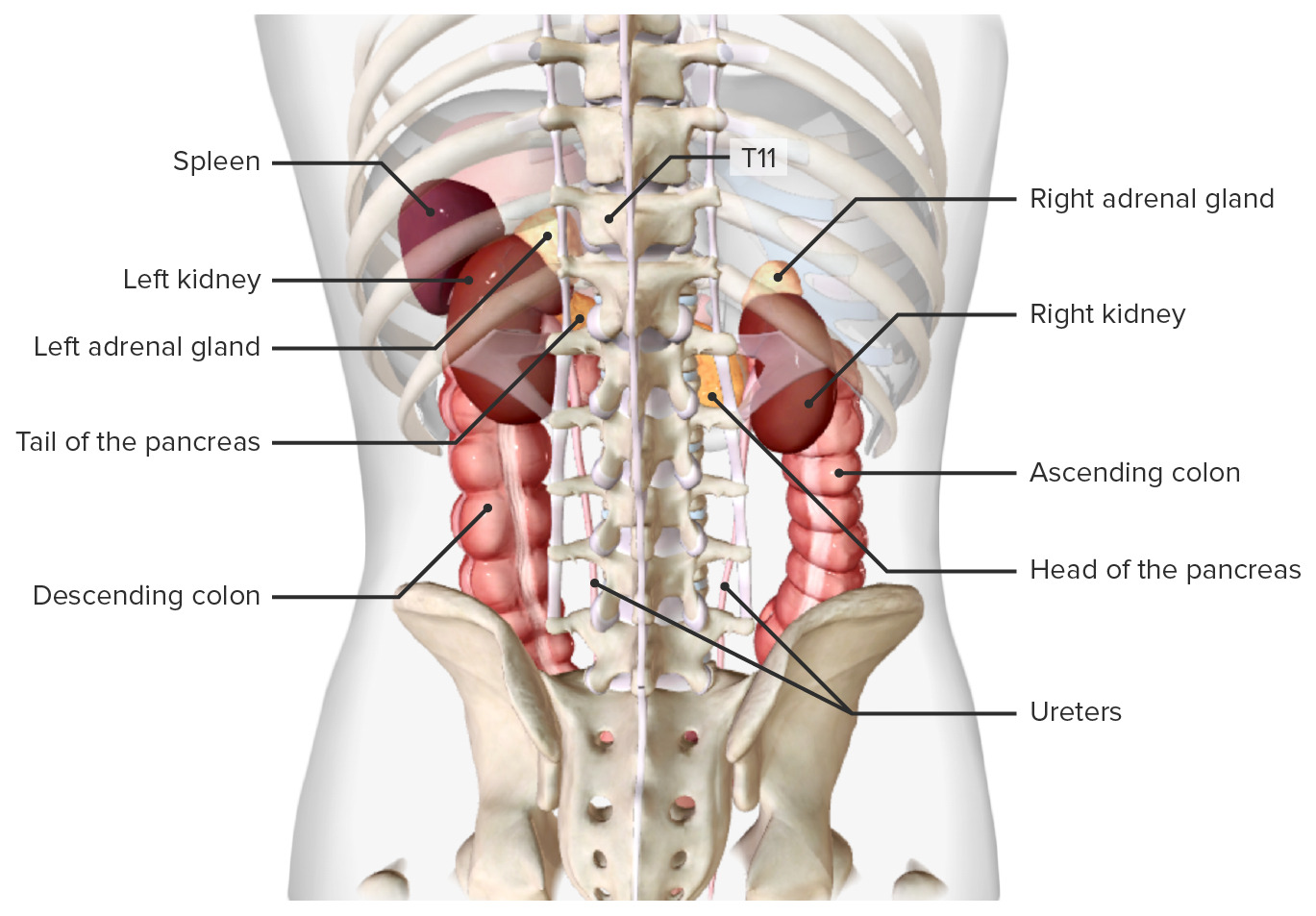Playlist
Show Playlist
Hide Playlist
Nephron
-
Slides 10 Human Organ Systems Meyer.pdf
-
Reference List Histology.pdf
-
Download Lecture Overview
00:00 Now, turn your attention to the left-hand diagram, and we're going to describe the structure of a nephron. Concentrate on, perhaps, the juxtamedullary nephron shown there, because it's drawn a little bit larger and a bit easier then to understand. On the right-hand side, you can see circular structures with a little white halos around them. They are the glomerulus in the renal, in the Bowman's capsule, that's part of the corpuscle, the renal corpuscle I'll describe in a moment. 00:40 And all the other profiles you see are tubule system profiles. 00:45 Looking at the juxtamedullary nephron, there's a round red structure. 00:49 The glomerulus, sitting in Bowman's capsule forming the renal corpuscle. 00:54 A tubular system leaves the renal corpuscle forming a coiled blue structure. 01:00 This is the proximal convoluted tubule, which continues as the proximal straight tubule or thick descending limb extending toward the medullary papilla. 01:11 This becomes the thin descending limb of the loop of Henle, forms the loop, then becomes the thin ascending limb. 01:18 This connects to a thicker red segment, the thick ascending limb. 01:23 This leads to another coiled section called the distal convoluted tubule, which empties into the collecting tubule. 01:31 Multiple collecting tubules joined to form the collecting duct. 01:35 Carrying urine to the papilla. 01:39 So make sure you understand then the tubule system of the nephron. Proximal convoluted tubule, descending thick limb, then thin segment, descending thin segment loop of Henle, ascending thin limb of Henle, and then the ascending thick limb or segment of the distal tubule and then the distal convoluted tubule emptying into the collecting tubule and then the collecting duct. They are the components of the nephron that function. They do all the important parts of the kidney does that you'll get explained to you in your physiology lectures. Let's now have a look at some of the histological details of those components. So if you can imagine a line or a section taken through that top part where the renal corpuscle is of the nephron you've been looking at, you'll see the sort of image you'll see on the right hand side. 02:45 Again, sections through the renal corpuscle and profiles through all those convoluted tubules, the straight tubules you'll see down towards the lower region and in the medulla. 02:57 Here is a diagram explaining the structure of the renal corpuscle.
About the Lecture
The lecture Nephron by Geoffrey Meyer, PhD is from the course Urinary Histology.
Included Quiz Questions
Which choice provides the CORRECT sequence of the tubules leaving the renal corpuscle?
- Proximal convoluted tubule, the loop of Henle (the U-shaped portion of the nephron consisting of the thick straight portions of the proximal and distal tubules and the thin segment between them), distal convoluted tubule, collecting tubule, collecting duct
- Proximal convoluted tubule, distal convoluted tubule, the loop of Henle (the U-shaped portion of the nephron consisting of the thick straight portions of the proximal and distal tubules and the thin segment between them), collecting tubule, collecting duct
- Loop of Henle (the U-shaped portion of the nephron consisting of the thick straight portions of the proximal and distal tubules and the thin segment between them), proximal convoluted tubule, distal convoluted tubule, collecting tubule, collecting duct
- Collecting tubule, proximal convoluted tubule, the loop of Henle (the U-shaped portion of the nephron consisting of the thick straight portions of the proximal and distal tubules and the thin segment between them), distal convoluted tubule, collecting duct
- Proximal convoluted tubule, distal convoluted tubule, the loop of Henle (the U-shaped portion of the nephron consisting of the thick straight portions of the proximal and distal tubules and the thin segment between them), collecting tubule, papilla of minor calyx
Which of the following statements best describes the anatomical location of the collecting ducts?
- They extend from the cortex to the medulla.
- They are confined to the medulla.
- They are confined to the cortex.
- They lie on the border of the cortex and medulla.
- They extend from the medulla to the cortex.
Which of the following is MOST ACCURATE?
- Glomeruli are in the cortex.
- Collecting ducts form the collecting tubules.
- The thick descending limb follows the distal convoluted tubule.
- A glomerulus is outside of Bowman's capsule.
Customer reviews
2,2 of 5 stars
| 5 Stars |
|
0 |
| 4 Stars |
|
1 |
| 3 Stars |
|
1 |
| 2 Stars |
|
1 |
| 1 Star |
|
2 |
Monotonous, difficult to follow and also factually imprecise. The corticial nephron and the juxtamedullary nephron cannot be the same thing, rather the LEFT nephron shown on the picture is cortical, while the entirety of the right nephron on the diagram is the juxtamedullaty nephron, even the part that is located in the cortex. Please review this and please, please, please use a pointer when presenting.
Literally you can not follow along at all. No idea how to figure out where on the image he is verbally referring to
The sir Geoffrey explains very well but i find it difficult to follow the explination on the histalogic image due to the lack of pointing out the structures i am not sure if i am looking at the right thing and i am always at doubt. Pls use pointers and thx for the attention.
Pointer helps a lot with histology. The instructor was clear and concise.




